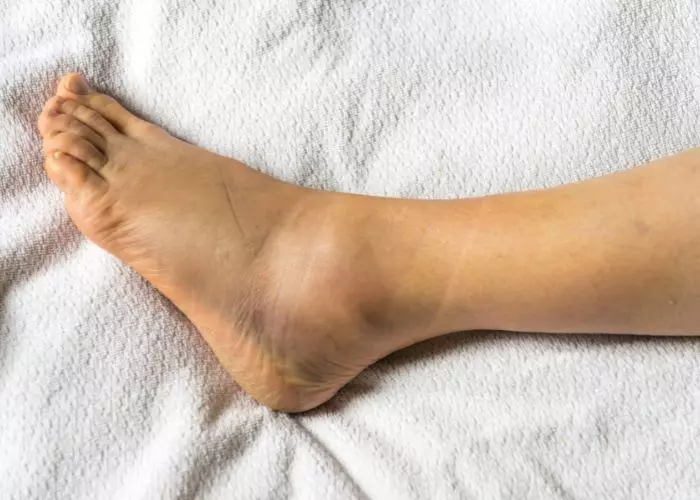Rash on ankle diabetes? If you suffer from a strong disease such as diabetes, it is possible that you get blisters or rashes on your ankles. It is usually caused by a fungus called Candida albicans or a diabetic disease called diabetic dermopathy.
In this article, we will show you in detail what the causes of rashes are on your ankles or feet and how you can treat these uncomfortable and painful imperfections. We appreciate your presence in our article and invite you to enjoy it to the fullest.

Rash on ankle diabetes
Diabetic dermopathy is likely to be the cause of rashes on your ankles. The emergence of reddish patches between one and two centimeters in diameter, which darken and form little crusts over time, characterizes this condition.
They might damage self-esteem since they are usually seen in the knees, ankles, thighs, or forearms, particularly in males, even if they have no major effects or cause discomfort. When diabetes is under control, however, they are cured. Fungal infections may occur as a result of diabetic dermopathy, which can damage the ankle region.

Cure diabetic dermopathy
Rashes that appear on your ankles or anyplace else on your body may be treated thanks to diabetic dermopathy. Although there isn’t much you can do to heal ankle rashes or remove this illness from your body. Diabetic dermopathy is treated in a variety of ways.
The lesions, often known as pimples, caused by diabetic dermopathy are completely harmless. They normally don’t need to be treated and fade gone after a few years, especially if blood glucose management is improved.
Candida albicans
Candida albicans infection is another potential cause of rashes on your ankles caused by diabetes. Invasive candidiasis is a fungal infection with a rising prevalence, affecting long-term immunocompromised patients, patients having significant surgery, catheterized or catheterized patients, and patients on broad-spectrum antibiotic treatment.
A yeast is referred to as Candida in scientific terms. It’s a fungus that may be found practically everywhere, even within your body. The fungus is normally kept under control by the immune system. It’s linked to itchy and rashy ankles caused by candida skin infections.

Treatment of yeast infections
Antifungal or antifungal therapy should be followed to get rid of itching, red blotches, or skin rashes on your ankles. Antifungals are medicines that stop fungus from growing on your skin in any shape or sort.
They have the potential to destroy candida Albicans fungus and other pathogens. Antifungals can usually clean up yeast infections in most individuals. Treatment may be more difficult if you have a compromised immune system.
Frequently Asked Questions
Does diabetes cause ankle rash?
Some diabetes rashes are unique to diabetics. When the blood sugar is in control, they often disappear. These rashes consist of: (bullosis diabeticorum) Blisters On the backs of the hands and feet, as well as the legs and forearms, painless blisters may develop.
What does a diabetic rash look like?
This skin ailment often starts as little, solid, raised lumps that resemble pimples. These lumps develop into hard, puffy areas of skin as the condition worsens. The patches may be brown, reddish, or yellow in color.
What does diabetes leg rash look like?
The characteristic skin lesions of diabetic dermopathy, sometimes known as “shin spots,” are light brown, scaly patches of skin that frequently appear on the shins. These blotches might be oblong or round. They are brought on by damage to the tiny blood arteries that provide nutrients and oxygen to the tissues.
Can sugar diabetes cause a rash?
Diabetes patients are more prone to fungal infections, particularly Candida albicans. This yeast-like fungus often develops in warm, damp places like the armpits or between the toes, where it produces a red, itchy rash that is commonly accompanied by tiny blisters and scales.
What does ankle rash look like?
Ankle rashes may be red, white, purple, or silver in appearance and may or may not itch. An ankle rash may have a flat, raised, bumpy, scaly, or scaly appearance in addition to skin cells that are flaking off or peeling. Ankle rashes may also take the form of dots, spots, patches, or solid, continuous lesions.
Control and avoidance of ankle rashes
Wear comfortable shoes to prevent your feet and ankles from injuries that might lead to ulcers and limb amputation. On the ankles, use a cream or gentle soap. Scratching scabs in the wrong spot is a recipe for disaster.
If any portion of your skin becomes purple, swells, reddens, pains, or has a fever, you should see a doctor very once. After a bath or shower, be sure to dry the region thoroughly; wearing lengthy stockings might result in further blisters on the ankles.

Conclusion
You can finally get rashes or blisters on your ankles due to the diseases or infections mentioned above, so it is always necessary that you follow the recommendations stipulated to avoid the spread of these and control the occurrence of blisters.
When you have diabetes, it is important that you also take care of your feet and the rest of your body, following recommendations both in diet and in physical activity and leisure. In this way, you will be able to lead a practically normal lifestyle without suffering from symptoms due to your disease.






![How Many Type Of Diabetes Is There [2022]](https://diabetes365care.com/wp-content/uploads/2022/08/How-Many-Type-Of-Diabetes-Is-There-400x250.webp)
![Itchy Feet With Diabetes [2022]](https://diabetes365care.com/wp-content/uploads/2022/08/Itchy-Feet-With-Diabetes-400x250.webp)

![How Many Type Of Diabetes Is There [2022]](https://diabetes365care.com/wp-content/uploads/2022/08/How-Many-Type-Of-Diabetes-Is-There-150x150.webp)
![Itchy Feet With Diabetes [2022]](https://diabetes365care.com/wp-content/uploads/2022/08/Itchy-Feet-With-Diabetes-150x150.webp)
![Rash Under Breast Diabetes [2022]](https://diabetes365care.com/wp-content/uploads/2022/08/Rash-Under-Breast-Diabetes-150x150.webp)
![Breakfasts For Gestational Diabetes [2022]](https://diabetes365care.com/wp-content/uploads/2022/08/Breakfasts-For-Gestational-Diabetes-150x150.webp)
![What Is The Causes Of Diabetes Insipidus [2022]](https://diabetes365care.com/wp-content/uploads/2022/08/What-Is-The-Causes-Of-Diabetes-Insipidus-150x150.webp)
![Symptom Of Diabetes In Pregnancy [2022]](https://diabetes365care.com/wp-content/uploads/2022/08/Symptom-Of-Diabetes-In-Pregnancy-150x150.webp)
![Rash On Ankle Diabetes [2022]](https://diabetes365care.com/wp-content/uploads/2022/08/Rash-On-Ankle-Diabetes-150x150.webp)
![Gestational Diabetes Babies Size [2022]](https://diabetes365care.com/wp-content/uploads/2022/08/Gestational-Diabetes-Babies-Size-150x150.webp)
![Sign Of Diabetes While Pregnant [2022]](https://diabetes365care.com/wp-content/uploads/2022/08/Sign-Of-Diabetes-While-Pregnant-150x150.webp)
![Can You Die Of Type 2 Diabetes [2022]](https://diabetes365care.com/wp-content/uploads/2022/08/Can-You-Die-Of-Type-2-Diabetes-150x150.webp)
![Skin Discoloration From Diabetes [2022]](https://diabetes365care.com/wp-content/uploads/2022/08/Skin-Discoloration-From-Diabetes-150x150.webp)
![Is Cucumbers Good For Diabetes [2022]](https://diabetes365care.com/wp-content/uploads/2022/08/Is-Cucumbers-Good-For-Diabetes-150x150.webp)
